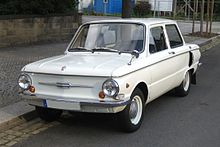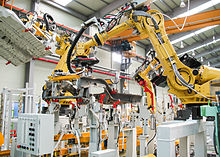Zaporisky Avtomobilebudiwny Zavod
| Запорізький автомобілебудівний завод Zaporisky Avtomobilebudiwny Zavod
|
|
|---|---|
| legal form | AG |
| founding | 1863 |
| Seat |
|
| Branch | Automobile manufacturer |
| Website | www.avtozaz.com |
Saporisky Awtomobilebudiwny Zavod ( Ukrainian Запорізький автомобілебудівний завод , shortly ЗАЗ , German transcription SAS , own appearance in the Latin writing system in English transcription ZAZ translated Saporischjaer automobile factory, also Russian Запорожский автомобилестроительный завод or transcribed Saporoschski awtomobilestroitelny zavod ) is a traditional Ukrainian car manufacturers in the city Zaporizhia . The industrial company founded in the Russian Empire with changing ownership, then, as in the later Soviet Union , manufactured various products, above all technology for agriculture.
The series production of road vehicles began in the early 1960s. A special characteristic of the first generation produced was the four-cylinder and air-cooled V-engine built into the rear of the vehicle . Several vehicle types were sold in the German-speaking countries, in particular in the German Democratic Republic (1967 to 1979 under the brand name Saporoshez ) and to Austria (with the name Eliette ) and other European countries.
In parallel with the last rear-wheel drive model, the production of a hatchback vehicle with a front engine began . Today's group manufactures vehicles under license for General Motors ( Daewoo , Chevrolet , Opel ) and also Mercedes-Benz . In addition to passenger cars , containers and garden furniture are also manufactured.
history
The Russian-German Mennonite Abraham or Abram Jacob Koop ( Russian Абрагамъ Яаковлевичъ Копъ ) founded in 1863 in the German village Schönwiese , Russ. Шенвизе (part of the German-Mennonite colony Chortitza ), today southern district of Zaporozhye , a small factory for the production of Heuschneidegeräten and windmill parts. Later he combined these and three other smaller factories into one company that specialized in the production of agricultural machinery and agricultural equipment.
The Koop family was expropriated during the Russian Revolution and the Russian Civil War by the communist regime and the work was continued under the name Коммунар (Kommunar) from 1921 (according to other sources from 1923) . The first threshing machine was built in 1929 , which was then produced in series from 1930 to 1941 and from 1947 to 1952; 129,724 copies in total.
On June 18, 1959, the company presented its first draft of a car, the SAS-965 "Saporoshez" , as a study, which went into series production a year later and was exported to several Eastern and Western European countries from 1965 onwards. In addition to Eliette for Austria, the motor vehicles for western countries were given the brand names Jalta (Yalta) and ZAZ . In 1966 the SAS-966 went into production as the successor to the SAS-965. It was presented as a prototype in 1961 . In 1976, the one millionth car, a SAS-968A , was delivered. From 1979 the series of the SAS-968M rolled off the assembly line , within three years its production could be increased to 600 pieces per day.
In 1987 the company began series production of its first front-wheel drive car with a water-cooled engine , the ZAZ-1102 Tavria ; the previous models all had rear-wheel drive . In 1989 the three millionth passenger car was built.
On June 30, 1994, the production of the SAS-968M was stopped with a celebration. From 1960 to 1994, a total of 3,422,444 cars with air-cooled rear engines were manufactured in Zaporozhye from the Melitopol engine factory (MeMZ). The focus was now entirely on the production of the Tavria.
In spring 1998 the company entered into the Ukrainian- Korean joint venture AvtoZAZ- Daewoo . In addition to a modernized version of the ZAZ-1102 Tavria , the Daewoo models Lanos , Nubira and Leganza were built from then on. Series production of the ZAZ-1103 Slavuta began in 1999 .
In 2002 the license production of vehicles of the Mercedes E-Class and ML-Class started, in January 2003 the license production of Opel Astra , Vectra and Corsa cars followed. The production of VAZ motor vehicles also began in 2003 . In 2004 the production of the Pick-up and Sens models , some with natural gas drive, started.
Models
Historical models (cars)
Saporoshez series
Tavria series
- ZAZ-1102 Tavria , station wagon, 3-door (1987-2007)
- ZAZ-1103 Slavuta , station wagon , 5-door (1999-2011)
- ZAZ-1105 Dana , station wagon, 5-door (1994–1999)
- ZAZ-110550 Tavria Pick-Up , as a panel van or pick-up (1993-2011)
Current models
As of February 2014, the model range consists of the following models:
Car
- ZAZ Lanos , a license production of the Daewoo Lanos , model designation in Russia from 2009: ZAZ Chance
- ZAZ Sens , economy version of the Lanos
- ZAZ Lanos Pick-up , panel van based on the Lanos
- ZAZ Forza , license production of the Chery Fulwin 2
- ZAZ Vida , license production of the Chevrolet Aveo
buses
- ZAZ A07A I-VAN , minibus on chassis from Tata Motors
- ZAZ A10 I-VAN , midibus
literature
- Harald H. Linz, Halwart Schrader : The International Automobile Encyclopedia . United Soft Media Verlag, Munich 2008, ISBN 978-3-8032-9876-8 .
Web links
- Official site of the company ZAZ (English)
- Official website of the company ZAZ (Russian)
- Official website of the entire UkrAvto group of companies (English)
Individual evidence
- ↑ Official website of the company (English)
- ^ Willi Vogt: Advertising. Mennonite Industry and Trade in Russian Publications . Internet project Mennonite history and genealogy . Neuwied, 2015.
- ^ Nico van Dijk: Automobiles were made by ...? Lulu Press. Raleigh, 2015. p. 65. ISBN 978-1326-45496-8 .













